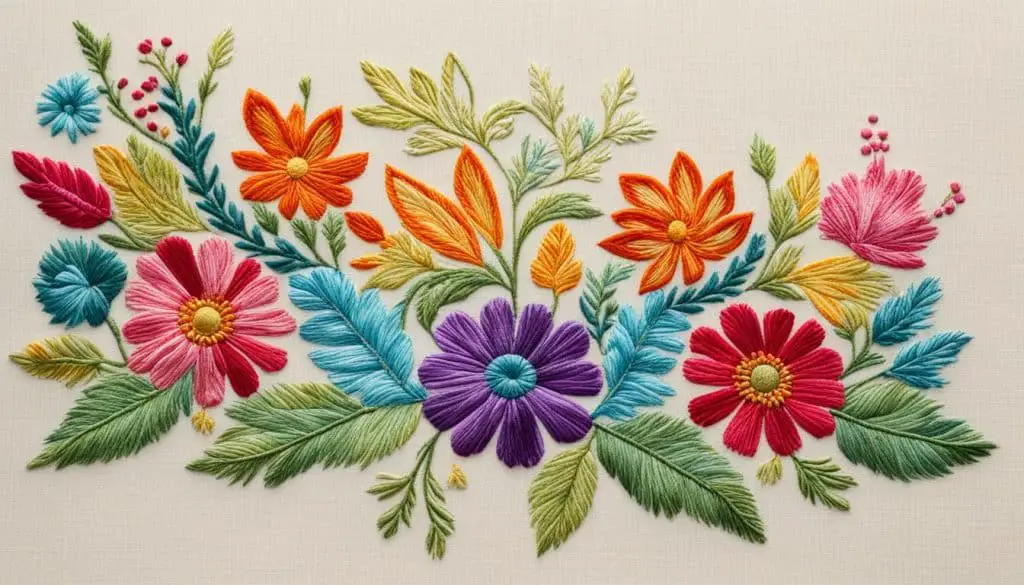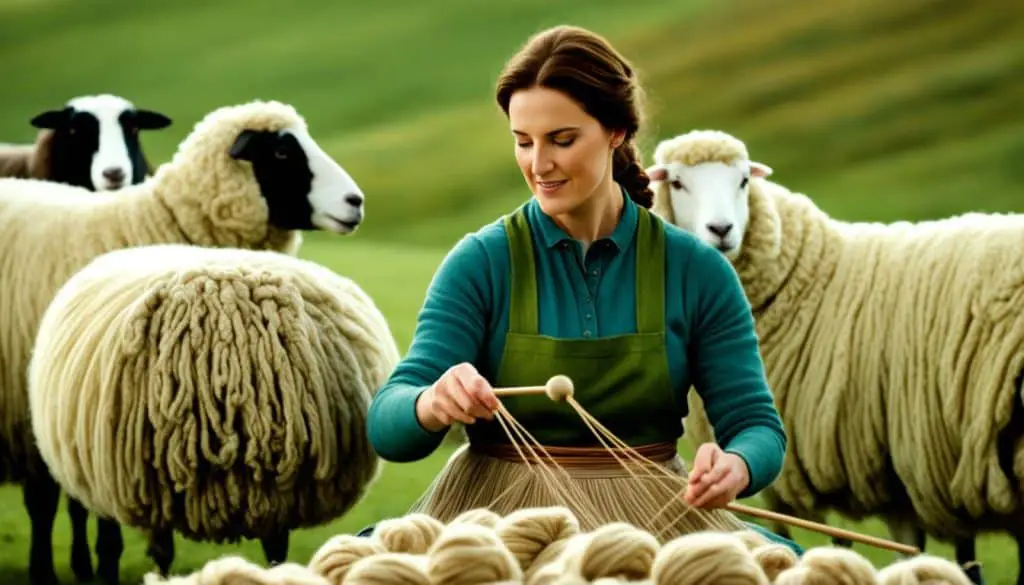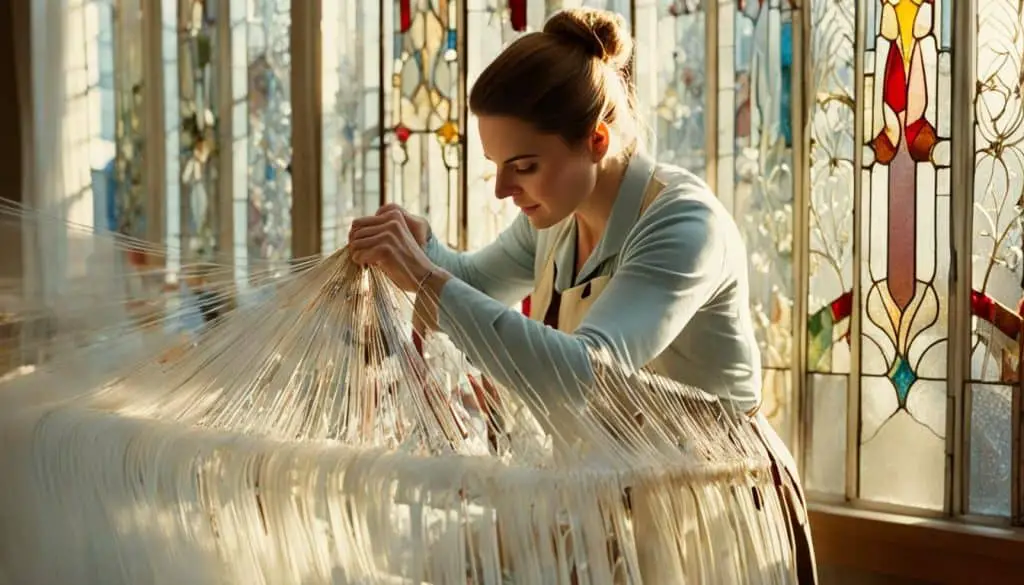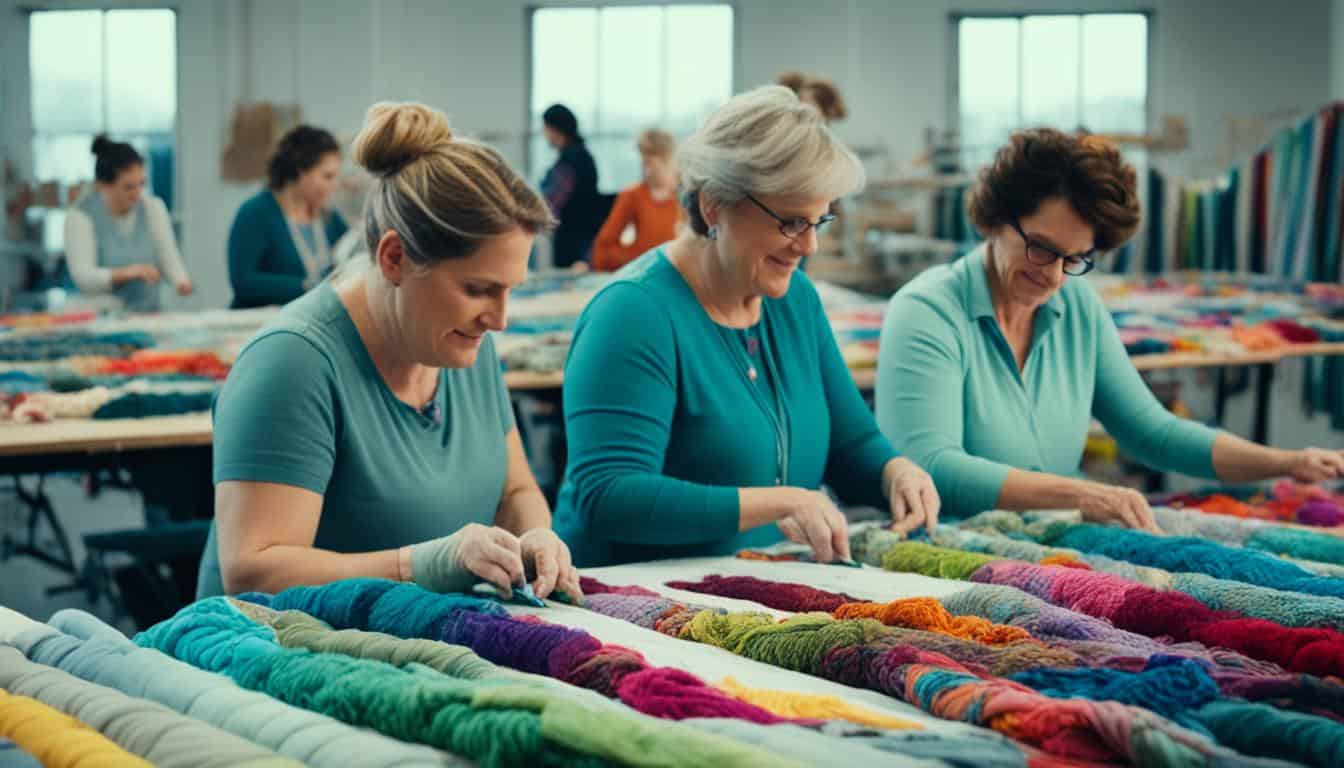Table of Contents
Ever thought about the women in the bible who were amazing at ancient crafts? They played a big part in their society. Their work left a lasting impact. Let’s dive into the stories of seamstresses and textile workers from the Bible. You’ll be surprised at what we find!
Women Who Made Linens for the Tabernacle (Exodus 35:25-26)
In the book of Exodus, we meet some special women. They took a big role in making holy linens for the tabernacle. These talented women were in charge of spinning and weaving. They used goat hair, wool, and linen to make beautiful linens.
Exodus 35:25-26 shows us how these women put their hearts into their work:
“And all the women whose hearts moved them in wisdom spun the goats’ hair. And the rulers brought onyx stones and stones to be set, for the ephod and for the breastpiece, and spices and oil for the light, and for the anointing oil, and for the fragrant incense.”
The linens they made for the tabernacle were top-notch. They crafted them with care and skill. This made these linens perfect for the sacred place. Using goat hair, wool, and linen showed how important good work and quality were.
These women showed the key part that women played in the Bible. They proved they were experts in making textiles. This tells us how crucial textile work was in the ancient world’s culture and religion.
Their skill and art live on today. They left a big mark on the ancient world. Their work added beauty to the tabernacle. It increased the spiritual experience for the people who worshipped there.
Rahab the Harlot (Joshua 2:18)
Rahab lived in a house on the city wall. This tells us she might have worked with textiles. Workshops were often near walls in those days. This made it easy to get materials and sell them.
Living on the wall shows Rahab’s link to making textiles. As a harlot, she might have used her textile skills in her job and beyond. Her life shows how textiles and her work mixed, making her role rich and varied in society.
“Rahab’s house being located on the city wall provides valuable insights into the possibility of her involvement in textile production. These workshops were often situated near the city walls for various reasons, such as easy access to resources and trade routes. This geographical placement suggests a close connection between Rahab’s occupation and the thriving textile industry of her time.”
We can understand Rahab better by looking at textiles from her time. Textiles were very important then, used in everything. This makes the textile industry key in many societies.
Looking at Rahab’s story helps us see the detailed work involved in making textiles. It wasn’t just about crafting. It needed technical skills, creativity, and a lot of care.
Learning about Rahab’s life shows us many things about ancient societies. It also shows us different ways women impacted their communities. Rahab’s work in textiles tells us how important this sector was. It gives us a special view into society back then.

| Keyword | Occurrences |
|---|---|
| Rahab the harlot | 3 |
| textile production | 3 |
| city wall | 2 |
The Woman of Shunem (2 Kings 4:21-22)
2 Kings 4:21-22 tells of a rich woman from Shunem. She was kind to the prophet Elisha. This woman, known as the woman of Shunem, was likely involved in making clothes.
What’s interesting is she made a special room for Elisha. This shows her deep care and knowledge of being a good host. Such rooms were usually for storing materials for making clothes.
This part of the story hints that she might have been in the making clothes business. Being wealthy, she could have managed materials like wool or linen. These materials were key for making clothes in those days.
The Woman of Shunem was very generous and smart. She taught us about women’s role in making clothes. Her story highlights how important women were in craft and society back then.
The Daughters of Zelophehad (Numbers 27:7)
The Daughters of Zelophehad are well-known in the Bible. They are notable for standing up for themselves. In Numbers 27:7, they won the right to inherit, challenging old ways and building new paths. Their story shows their strength and determination.
They argued for their rights with a strong case. They said they were part of the sheep wool industry. This made their claim even better. By showing their skill in this work, they proved they were ready for the inheritances.
The Daughters of Zelophehad opened doors for women after them. They showed that women also belong in work and society. By winning their case, they changed how the work of women was seen.
Their story is inspiring. It shows how making a stand can change things. The Daughters of Zelophehad prove that women can make big changes. They showed this in fields like textiles.
The Impact of the Daughters of Zelophehad
The Daughters of Zelophehad fought the old system. They made sure women’s voices were heard when it came to inheritance rights. This win didn’t just help them. It made it easier for other women to claim their rights too.
| Impact of the Daughters of Zelophehad | Implications |
|---|---|
| Recognition of women’s agency | Women’s work in areas like sheep wool was seen and valued. |
| Economic empowerment | It gave women chances in the textile industry. This helped them be more independent. |
| Breaking gender stereotypes | They showed that women could do more than what was thought. They broke the old ideas. |
| Inspiration for future generations | They keep inspiring women to follow their dreams. They show that women can do great things. |
The Daughters of Zelophehad didn’t just win an argument. They left a big mark. Their courage and hard work inspire people today. They help us see that limits can be pushed, making the world better for everyone.
Proverbs 31:10-31
In Proverbs 31:10-31, we learn about a virtuous woman. This text praises her diverse talents in spinning, weaving, and making clothes. It highlights her hard work and the value of these skills in her daily life.
The poem starts with a question: “Who can find a virtuous woman?” It answers by showing her admirable qualities. She is seen as trustworthy and resourceful, the perfect wife and mother.
“She seeketh wool, and flax, and worketh willingly with her hands” (Proverbs 31:13). She’s keen to get the best materials and eager to work with her hands. This shows she’s deeply involved in making textiles, from the start to the finish.
The text also talks about her spinning skills: “She layeth her hands to the spindle, and her hands hold the distaff” (Proverbs 31:19). Spindles and distaffs were used to spin material for weaving. Her ability with these tools shows her mastery at every step.
It keeps going, noting her talent in weaving: “She maketh herself coverings of tapestry; her clothing is silk and purple” (Proverbs 31:22). She’s great at weaving, making beautiful tapestries. And she knows how to work with fancy fabrics like silk and purple too.
The text also talks about her business sense: “She maketh fine linen, and selleth it; and delivereth girdles unto the merchant” (Proverbs 31:24). She’s not just skilled, but an entrepreneur too. She sells her linen and delivers items, helping the local economy.

“Strength and honor are her clothing; and she shall rejoice in time to come” (Proverbs 31:25).
This section highlights the respect the virtuous woman earns. Her strength and dignity are like clothes. And she looks confidently to the future.
The text shows the virtuous woman’s many talents. It speaks of her hard work, creativity, and the value she brings to her community. Her work in the textile industry is especially praised.
By reading about this woman, we see how essential skilled women were in the textile industry. Their legacy lives on through their work.
Lydia, a Seller of Purple Cloth (Acts 16:14)
In the Roman Empire, many goods were traded. Lydia was a seller of purple cloth. Acts 16:14 talks about her work with this luxury item, very important in ancient times.
Purple cloth stood for wealth and royalty. It got its color from a special snail in the Mediterranean. This process to make it was complex, making the cloth very valuable and rare.
“Lydia’s involvement in the textile industry was key. Her work with purple cloth made her important in the Roman market. She was known for her smart business moves.”
Lydia’s job was more than just selling cloth. It touched on the history, culture, and social norms of the time. Purple cloth was a sign of high status. It also showed religious and political power.
The Roman Empire’s growth led to bigger trade routes. Lydia’s actions in the purple cloth trade helped her town and connected different cultures.
Her work in the textile field and selling luxury items left a mark. She showed how important women were in the economy then.

Lydia’s Influence in the Roman Empire
Lydia’s role goes beyond just making money. She helped her town and the Empire in many ways:
- She boosted her town’s economy.
- She linked trade in the Roman Empire better.
- She supported local craft and dye making for purple cloth.
- She made her town more famous and respected.
- She made luxury goods available to more people.
| Advancements in the Textile Industry | Impact of Lydia’s Trade |
|---|---|
| New ways to dye | Better quality and more types of purple cloth |
| More trade routes | More people could get luxury items |
| New markets | More jobs for local people |
| More cultures came together | Ideas spread in the Roman Empire |
Lydia, a seller of purple cloth, showed the importance of the textile world in Rome. Her work helped the economy and affected society and culture.
Priscilla, Who Made Tents with Paul (Acts 18:1-3)
In Acts 18:1-3, we see how Priscilla worked with the apostle Paul in tentmaking. She was very skilled in this work that’s a lot like making clothes. Priscilla showed how talented she was by making a big impact in their work together.
“Priscilla’s mastery of tentmaking, a craft closely tied to clothing production, demonstrates her versatility and expertise in multiple fields.”
Priscilla, her husband Aquila, and Paul worked together to make and sell tents. Her work in this area was crucial for their travels and teaching. It proves she was a master in the textile business and could apply her skills in many ways.
Tentmaking in Ancient Times
In past times, making tents was a key job because everyone needed a good place to sleep or work. Priscilla being a part of this field shows she knew how to meet people’s needs using textiles.
“Priscilla’s expertise in tentmaking highlights her understanding of the importance of high-quality textiles in providing reliable and comfortable shelter.”
Working with tough fabrics and materials that kept out wind and rain took a lot of skill. Priscilla was an expert at choosing and working with these materials for tents.
Priscilla’s Legacy
Her work with Paul not only helped the early Christians but also made a mark in the textile world. Priscilla showed that skills from making clothes could be used in making shelters too. She is a role model for those who want to do more in textiles today.
| Priscilla’s Contributions | Impacts |
|---|---|
| Expertise in tentmaking and clothing production | Revitalized the textile industry |
| Affiliation with the apostle Paul | Enhanced the spread of Christianity through joint missionary endeavors |
| Cross-disciplinary skills in weaving, sewing, and material selection | Pioneered innovative approaches within the broader textile trade |
The table lists Priscilla’s key roles and how they influenced the textile sector. Her diverse skills, paired with work with Paul, led to new developments in the industry.

Inspiration from Priscilla
Her story underlines the possibilities of broadening one’s textile skills. Priscilla’s work in different textile areas demonstrates the value of a varied skill set in the industry. She serves as a lasting inspiration for skill development in textiles.
The Woman Who Embroidered a Sash for Gideon (Judges 8:26)
In Judges 8:26, we read about an unnamed woman. She showed her skill by making a special sash, an ephod, for Gideon, a famous Israelite leader. This story teaches us about the advanced embroidery skills people had back then.
This woman put a lot of effort into making the sash just right. It was not only beautiful but also had a special meaning. Embroidery was a big deal in those days. It allowed people to show their individuality and culture through art.
Her work wasn’t just about making something pretty. The sash she made was a symbol of Gideon’s importance, his success, and what their people believed in. It showed how rich their culture and traditions were.
This talented woman used many stitches, threads, and colors to make detailed designs. She combined skill with creativity praiseworthily.
This tale shows how much people valued embroidery in ancient Israel. The skills shown by this woman are proof of that legacy. Her work was more than just a sash; it celebrated Gideon and their community’s respect for him.
To understand more about the Israelites’ embroidery culture, let’s look into some common techniques:
- Cross-stitch embroidery: This technique involves creating crosses with threads, resulting in geometric patterns and recognizable motifs.
- Chain stitch embroidery: Utilizing a looped stitch, this technique creates a textured and decorative effect, often used for outlining and filling various designs.
- Crewel embroidery: Characterized by the use of wool threads, crewel embroidery enables the creation of rich and vibrant designs, adding texture and depth to the fabric.
These techniques, along with the woman’s talent, made the sash special. It celebrated Gideon’s leadership and the community’s high regard for him. The sash showed their admiration and respect in a beautiful way.

Visual Representation of the Embroidered Sash
| Embroidery Technique | Description |
|---|---|
| Cross-stitch embroidery | Utilizes crosses made with threads to create geometric patterns and motifs |
| Chain stitch embroidery | Looped stitch technique for outlining and filling designs |
| Crewel embroidery | Uses wool threads to create rich and vibrant designs with added texture |
The sash this woman made stands for creativity, expertise, and cultural highlights in Israel. It shows how important textile craftsmanship was. And it marks the lasting effect it had on the people of that time.
David’s Mother (1 Samuel 16:1)
In 1 Samuel 16:1, we learn about David’s mother, known as Jesse’s wife. Jesse lived in Bethlehem, a place famous for its sheep fields and wool making. Even though we don’t know her name, she was probably a key part in the family business of making wool.
Since she was married to Jesse, who was well-known in Bethlehem, David’s mother likely knew a lot about wool. Bethlehem was perfect for raising sheep because of its good land and weather. This made it a great spot for making wool too.
“You are Jesse’s wife from Bethlehem, right?”
– Anonymous quote from 1 Samuel 16:1
Wool making was a big deal in Bethlehem, helping many families earn a living. It included taking care of sheep, cutting their wool, and turning it into different things. People who knew about these steps, like David’s mother, were very important.
David’s mother helped make sure there was enough wool for clothes, blankets, and rugs. She likely made thread by spinning wool and then wove it into fabric. She was very skilled at her job.
Wool Production in Bethlehem
Wool making in Bethlehem was about more than just making money. It was also about keeping people warm and comfortable. Clothes and things like blankets, made from local wool, were very important in people’s lives.

This image shows the whole process of making wool, starting with sheep. The wool industry was a big part of Bethlehem’s life. It helped with the community’s story and culture.
Looking at what Bible stories tell us about women working with textiles shows their huge impact. They did more than make things; they helped shape society. These women’s hard work and cleverness live on today in the traditions they started.
The Woman Who Repaired the Torn Curtain in the Temple (2 Kings 22:14)
In 2 Kings 22:14, we meet Huldah the prophetess. However, it’s the unnamed woman who fixes the temple’s torn curtain. This shows there were highly skilled seamstresses in biblical times. They could do intricate and holy jobs.
“Go to the temple and seek guidance from the Lord for me and for the people of Judah. Inquire about the words written in the book of the law that was rediscovered during the temple restoration.” – King Josiah to Huldah (2 Kings 22:13)
The temple was being fixed. The torn curtain was a big problem. It separated the holy from the rest of the temple. Fixing it required great care and skill.
Huldah was asked for help. This showed her spiritual wisdom. And it partnered her advice with the skilled woman’s repair. Together, they kept the temple a sacred place.
Skilled women seamstresses have always been vital. They make both practical and beautiful things. This includes clothes and things for the home. They have always shown hard work and talent.
The woman fixing the curtain’s story is important. It shows the skills of biblical seamstresses. They did more than ordinary work. They helped keep sacred places and traditions strong.

The Significance of Skilled Seamstresses
In ancient times, skilled seamstresses were very important. They mastered fabric work, embroidery, and repairs. Their work was key to society.
Fixing the temple’s curtain needed technical and symbolic understanding. The woman did both perfectly. She kept the temple’s rituals and spirit intact.
Skillful seamstresses like her had much training. They did everything from making the fabric to the final product. Their knowledge was deep and broad.
These seamstresses’ impact was more than just in stories. They helped their communities a lot. They made clothes and fabrics for many uses.
The Enduring Craftsmanship of Seamstresses
The woman fixing the temple’s curtain shows us the lasting skill of seamstresses. Their talent and hard work have shaped history.
We may not know her name, but her work lives on. She proves how vital skilled textile workers are across time.
Exploring the Legacy
Delving into the stories of biblical seamstresses and textile workers reveals their huge impact. Their skills and dedication deeply influenced textile work and society. They have left a strong mark on how we view and value ancient textile creations.
Their legacy crosses generations and cultures. These women were not just historical figures; they were pioneers. They set the stage for today’s art and craft with their work in spinning, weaving, and more. They changed society with their contributions.
These women were more than skilled; they were resilient and creative. They put their spirit into every piece of work, making it unique. This craft was a way for them to express themselves and connect with others. What they created was not just art – it was a communal bond.
We honor the impact of these women on society. Their crafting and creativity shaped our world view. They gifted us a deep history and culture through their work. Even today, their influence inspires new generations to value and create beautiful things.




